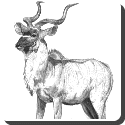 Kudu — The Kudu are two species of antelope Lesser Kudu and Greater Kudu.
Kudu — The Kudu are two species of antelope Lesser Kudu and Greater Kudu.
Lesser Kudus come from the savannas near acacia and commiphora shrubs. They have to rely on thickets for protection, so they are hardly ever seen in the open. While Weaker Kudus live in the woodlands and bushlands.
Like many other animals, male kudus can be found in bachelor groups, but they are more likely to be widespread. Males do not have great long shows for dominance it is usually quick and peaceful, because one male will give the most lateral show and stand up front and make himself look big. Males only are seen with females in the mating season, and they’ll only be in groups of 6-10 with their offspring. Calves grow very quickly and at six months are fairly independent of their mothers.
When pregnant the female will leave the herd and give birth. They will leave the newborn lying out for 4-5 weeks the longest period of any antelope. Then the calf will start meeting its mother for short periods in times. At 3 or 4 months will be with her constantly. And at about 6 months they will join the group.
Kudus are browsers and eat leaves and shoots from a variety of plants. In dry seasons, they eat wild watermelons and other fruit for the liquid they provide. The lesser Kudu is less dependent on water sources than the greater kudu.
Many predators, such as big cats, wild dogs, hyenas, eagles and pythons hunt kudu and their young. Kudu numbers are also affected by humans hunting them for their meat, hides and horns, or using their habitats for charcoal burning and farming. Kudus are highly susceptible to the rinderpest virus, and many scientists think recurring epidemics of the disease have reduced kudu populations in East Africa.
The Greater Kudu (Tragelaphus strepsiceros) is a woodland antelope found throughout eastern and southern Africa. Despite occupying such widespread territory, they are sparsely populated in most areas, due to a delicining habitat, deforestation and hunting. An adult can weigh from 195–315 kilograms (though the female tends to be lighter) and grow to be 1–1.5 metres tall at the shoulder, with a length of 1.95–2.45 metres
They have a narrow body with long legs, and their coats can range from brown/bluish-grey to reddish-brown. They possess between 4–12 vertical white stripes along their torso. The head tends to be darker in colour than the rest of the body, and exhibits a small white chevron which runs between the eyes.
Male Greater Kudus tend to be much larger than the females, and vocalise much more, utilising low grunts, clucks, humming, and gasping. The males also have large manes running along their throats, and large horns with two and a half twists, which, were they to be straightened, would reach a length of 1 metre on average. However, the male horns do not begin to grow until the male is between the age of 6-12 months, twisting once at around 2 years of age, and not reaching the full two and a half twist until they are 6 years old.
Males weigh between 190-270 kg while females weigh between 120-210 kg, the females don’t have horns while the bulls have horns that average 120 cm in length with the record being 187.64 cm.
 Kids Portal For Parents India Kids Network
Kids Portal For Parents India Kids Network






